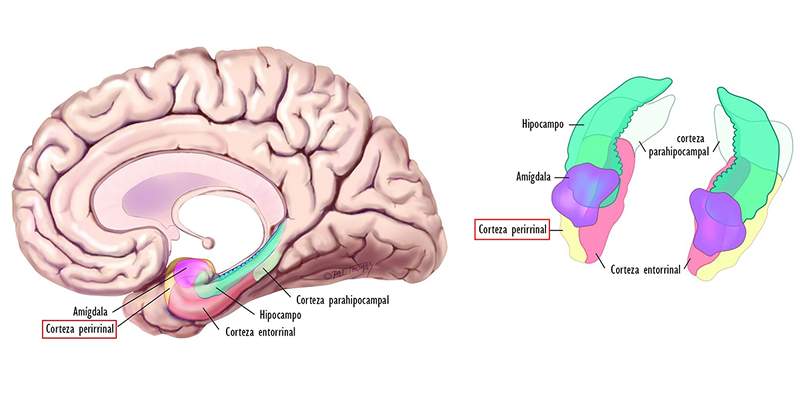Perirrinal cortex, structure and function

- 4614
- 21
- Gregory King
Perirrinal cortex is a region of the brain located in the temporal lobe, forming part of the limbic system. This brain area has a very important role in various cognitive functions, in particular the memory and recognition of objects.
It is believed that the peririnal cortex plays a critical role in the ability to recognize the familiarity of an object. In other words, this part of the brain Help identify objects or situations that we have found before. For example, if you see a type of fruit that you have eaten before, the perirrinal cortex would help you recognize that fruit and remember that you have already seen and proven it.
Location and structure of the perirrinal cortex
Perirrinal cortex is a region of the brain that is in the limbic system, it is a set of brain structures involved in functions such as emotion, memory and behavior. Specifically, the perirrinal cortex is located in the medial temporal lobe, which is often associated with memory and auditory processing.
This structure is part of the hippocampus complex in the brain and is divided into two main regions: The anterior peririnal cortex (also known as area 35) and The posterior peririnal cortex (or area 36).
These two areas have differences both in their structure and in their connections. Area 35 of the anterior peririnal cortex has a lower cell density than area 36 of the posterior peririnal cortex. In addition, each of these areas has its own unique sets of neuronal connections and can have different roles in memory and processing of sensory information.
Explicit learning and its relationship with the medial temporal lobe
The perirrinal cortex is intimately connected with other areas of the brain, which allows you to fulfill your functions of Memory processing and emotions. Some of the areas with which it connects are the entorrinal cortex, the hippocampus, the prefrontal cortex and the tonsil. Receive sensory information from several associative cortical areas. In particular, high -order visual information reaches the perirrinal cortex through the areas of the ventral temporal lobe, which are involved in the Complex visual processing.
As for the cellular structure, the perirrinal cortex, like other cortical regions, is composed of neurons (the main cells that transmit signals in the brain), as well as glial cells (which support and protect neurons). Neurons in the perirrinal cortex include both excitatory neurons (which increase the activity of other neurons) and inhibitory neurons (which reduce the activity of other neurons). This mixture of types of neurons allows a wide range of information processing in the perirrinal cortex.
Functions of the perirrinal cortex
The functions of the perirrinal cortex are mainly related to memory, recognition and emotionality. Although it is still investigating, it has been identified that it is present in the following functions:
- Recognition of objects: Perirrinal cortex plays a crucial role in the ability to recognize objects. This not only implies recognizing the object itself, but also its "familiarity". For example, if you see a pencil, your perirrinal cortex not only helps you identify it as a pencil, but also allow you to know that you have seen pencils before and you are familiar with them. When this area of the brain is damaged, the ability to recognize objects can be affected.
- Episodic memory: Among its functions is also the processing of episodic memory, which is the ability to remember specific events of our life. The perirrinal cortex allows remembering the specific details of these events, such as what objects were present. Again, damage to this area can hinder the recovery of these specific details.
- Semantic memory: Some investigations suggest that it can be involved in semantic memory, which is our general knowledge warehouse on the world. This could include facts such as "a pencil is used to write".
- Emotional processing: Although this is not its main function, this structure has connections with other areas of the brain involved in emotional processing, such as the amygdala. This means that you can play a role in the formation and recovery of emotional memories. For example, if you see an object that has caused you fear in the past, your peririnal cortex could help you remember that emotion and react accordingly.
- Work memory: Working memory is the ability to maintain information in the mind for a short period of time while we perform cognitive tasks. Although this process continues to be investigated, there are indications that the peririnal cortex could play a role in this function.
- Attention: In addition, some studies have suggested that perirrinal cortex is responsible for certain aspects of attention, especially in regard to the orientation of attention to objects of emotional importance or relevance for the tasks in question.
Entorrinal cortex: We reveal your secrets
References
- Aggleton, j. P., & Wright, N. F. (2017). 'Interaction model of the amygdala and the perirrinal cortex in the recognition of emotional memory'. Neuroscience Magazine, 20 (3), 131-140.
- Norman, g., & Eacott, M. J. (2004). 'Implications of the perirrinal cortex in episodic memory: findings and perspectives''. Neuroscience and behavioral biology, 28 (6), 671-685.
- Image extracted from: https: // www.Ajnr.org/content/36/5/846
- « What is empathy? Main characteristics and their use in therapy
- The parahypocampal cortex structure and function »

